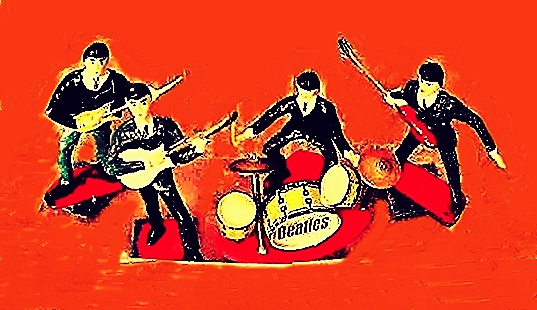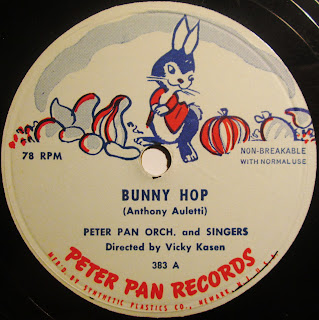Some big-band Beatles in the mix, courtesy of Enoch Light, Lawrence Welk, Sammy Kaye, and Buddy Morrow, and no fewer than five covers of A Hard Day's Night, courtesy of Enoch, The Kingsmen, Johnny Rivers, Alshire's famous Frank "88" Malone (who?), and, in the best Peggy Lee manner, Chris Connors. Then, Johnny Rivers again, with Can't Buy Me Love, the Buckinghams with a 1966 interpretation of I Call Your Name, an excellent Lettermen rendition of For No One, a Dixieland Sgt. Pepper's... by Andre Kostelanetz, a swinging Eleanor Rigby by Michael Dees, and the Supremes with You Can't Do That (but they do, and more than adequately). Meanwhile, Homer and Jethro's 1964 take on I Want to Hold You Hand is typical of the opinion, on the part of many professional, established recording musicians of the day (and H&J were highly accomplished), of the Fab Four's music: Annoying, monotonous low-calorie noise for screaming teens and pre-teens--a pop-music aberration soon to fade from the scene (and we know how that worked out). And maybe I'm reading too much into this version of She Loves You--after all, Homer and Jethro had for years been specializing in take-downs of current chart hits. But this particular lampoon complies too closely for coincidence with the standard dismissals of Beatlemania when that craze first exploded; the most hilarious parody of this type being Allan Sherman's classic Pop Hates the Beatles (also 1964).
And Ray Conniff is back with an effective cover of the Starr-Harrison Photograph, a track I didn't think I had ripped (but which, obviously, I had). As for the New Christy Minstrel's I Want to Hold Your Hand (speaking of), their take is certainly different. Meanwhile, Ronnie Aldrich's two pianos, along with the London Festival Orch., perform a memorable Because--the type of Beatles number which calls for this type of concert-hall version. As for the "live" Johnny Rivers Fab-Four renditions, my ears get the feeling that the audience chatter was added after the fact, though I'm not sure. Meanwhile, Anne Murray's 1974 Day Tripper is very 1974, which I suppose is to be expected. Not a bad cover at all. Even better is Johnny Mathis' My Sweet Lord, which the singer handles superbly. And, whoever he was, Frank "88" Malone performs a nice honky-tonk Hard Day's Night for Alshire Records around 1968 or 1969, looks like. And the Kingsmen's Bill Black-esque take on the same tune is terrific, though as with Rivers, the live-ness of the performance is doubtful.
Of the big-band renditions, I'm inclined to go with Buddy Morrow. Then again, Sammy Kaye's Eight Days a Week is terrific, and it's impossible to miss with Enoch Light. In sum, I'd rather not have to pick. And Percy Faith's My Sweet Lord has a fine rock feel, and it's impressively true to Harrison's original. I was expecting something more traditionally FM-radio-EZ, but it really moves.
And Floyd Cramer does a fine job with a Beatles classic which deserved a greater number of covers: I'll Follow the Sun, from the first Beatles LP I ever owned (The Beatles '65). At the time, and since my budget was typically limited to 45s, LPs seemed like a miraculous, almost impossible proposition--all of those tracks on a single platter! Years later, I'd buy my first Beach Boys LP at a discounted price (Capitol was cutting the BBs from its catalog): 1964's All Summer Long, in trashy Duophonic "stereo," though at the time (and on our cheap portable phonograph) it sounded just fine. Anyway, some real happening homages for this post...
DOWNLOAD: Fab Forgeries Pt. 6.zip
A Hard Day's Night--Enoch Light and His Orch. (1964)
My Sweet Lord--Johnny Mathis (1971)
Eight Days a Week--Sammy Kaye and His Orch. (1965)
A Hard Day's Night--The Kingsmen (1965)
Sgt. Pepper's Lonely Hearts Club Band--Andre Kostelanetz (1975)
Eight Days a Week--Enoch Light and the Light Brigade (1965)
Eleanor Rigby--Michael Dees (Arr. by Bob Bain, 1968)
I Want to Hold Your Hand/And I Love Her--Enoch Light and His Orch. (1964)
Photograph--Ray Conniff (1974)
Please Please Me--Buddy Morrow and His Orch. (1964)
Because--Ronnie Aldrich and His Two Pianos With the London Festival Orch. (1970)
A Hard Day's Night--Johnny Rivers (1965)
She Loves You--Homer and Jethro (1964)
I Want to Hold Your Hand--The New Christy Minstrels (1966)
A Hard Day's Night--Frank "88" Malone
I'll Follow the Sun--Floyd Cramer (1965)
You Can't Do That--The Supremes (1966)
Get Back--Paul Mauriat and His Orch. (1969)
Can't Buy Me Love--Johnny Rivers (1964)
I Call Your Name--The Buckinghams (1966)
Hey Jude--Lawrence Welk (1969)
My Sweet Lord--Percy Faith, His Orch, and Chorus (1971)
For No One--The Letterman (1967)
A Hard Day's Night--Chris Connor (1965)
Day Tripper--Anne Murray (1974)
Lee





.JPG)













































